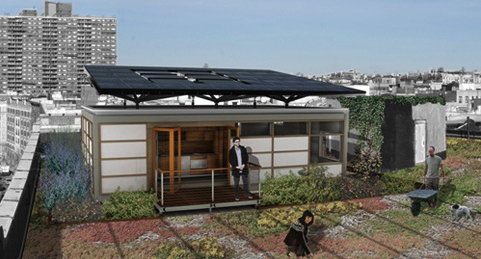
Image Credit: Bernard and Anne Spitzer School of Architecture and the Grove School of Engineering, of the City College of New York
Image Credit: Bernard and Anne Spitzer School of Architecture and the Grove School of Engineering, of the City College of New York The Solar Roofpod’s modular components, packaged in 5-ft. 4-in. by 8-ft. bundles, are designed to be transported via service elevator or stairway to an urban rooftop, where they are assembled into a one-bedroom home of about 750 sq. ft. The home sits atop a steel bolt-together dunnage system designed to distribute the weight of the house and dunnage framing evenly over the rooftop and also support planter bins irrigated by storm water and gray water. The Roofpod core, including a thermal storage tank serving the home’s thermal-collector system, which will be used to heat and cool the house. Because the density of residential construction in New York City is already so high, Team New York’s Solar Roofpod aims to exploit one of the city’s few remaining residential frontiers: the rooftops of buildings. Solar Rooftop’s curtain-wall envelope is made of 64 wood-framed, airtight building blocks. Some are opaque, some are translucent, and about 25% of the curtain wall is transparent. Solar Roofpod’s solar collectors – for hot water, heating, and air conditioning – and its photovoltaic arrays are mounted on an adjustable trellis that can be tilted to maximize solar exposure. In addition to the house, the dunnage frame supports garden planters and decking. The installation also will reduce the host building’s exposure to the summer sun. Painting Solar Roofpod’s dunnage frame. Solar Roofpod will feature a tongue-and-groove floating floor of cork, walls of birch plywood paneling, drywall ceilings, and bamboo-based “plyboo” paneling on the walls of the service core.
Densely packed and pricey as it is, New York City usually isn’t thought of as fertile ground for single-family-home development, particularly if the goal is to keep construction costs low. And yet Team New York – a collaboration of students and faculty at the Bernard and Anne Spitzer School of Architecture and the Grove School of Engineering, of the City College of New York – has found a comfortable place in the city for the single-family concept to roost: the rooftop. The logic behind the strategy is straightforward. Most buildings in the city have a rooftop — there is an estimated 1.6 billion sq. ft. of roof space in New York — and many of those rooftops are flat. Nothing good about a flat roof, you say? Team New York would disagree. “Our most wasted resource is the sun and our most wasted space is our rooftops,” the team declares in a video for its Solar Decathlon entry, Solar Roofpod, a modular home designed to be built on the rooftops of midsize apartment buildings and commercial buildings.
Live at the International Builder’s Show
The pieces of the 750-sq.-ft. house, and the bolt-together steel parts for a dunnage structure that evenly distributes the weight of the Solar Roofpod and its decking over the host building’s roof, are small enough to be transported in a service elevator or hauled up a stairwell (the team has already tested these ideas). Catching the sun in an urban environment The building features a curtain-wall envelope that consists of 64 wood-frame, airtight “building blocks,” each with an enameled Vacurex double-plate glass panel, whose vacuum insulation has an R value of 20. Some of the panels are opaque and some are translucent, although about 25% of the curtain wall is transparent. The house also is equipped with awning windows made by Raico Bautechnik. The wood-frame building blocks are insulated with closed-cell spray foam, which, in combination with the Vacurex, brings the exterior walls to R-50. In addition to air sealing the panels with the spray foam insulation, the team will use plenty of sealing tape on seams. One of the project’s faculty leaders, Christian Volkmann, says the building is expected to achieve airtightness of 1 to 1.5 air changes per hour at 50 Pascal pressure difference. ThermaSteel composite panels are being used for the roof and floor, bringing their respective R values to 55 and 45. Exploiting the solar exposure above and the dunnage structure below An adjustable trellis on Roofpod’s roof will support 550 sq. ft. of photovoltaic panels, with 9.6 kW of capacity, and 157.5 sq. ft. of solar thermal collectors that will serve a 240-gallon storage tank for heating and cooling the house.
MORE INFORMATION Team New York Web page DOE Web page for Team New York GBA Resource Guide for 2011 Solar Decathlon
The Roofpod interior will feature a tongue-and-groove floating floor of cork, walls of birch plywood paneling, drywall ceilings, and, on the walls of the central core, bamboo-based “plyboo” paneling. Like the house itself, the project’s exterior decking will be supported by the steel dunnage system, which also will accommodate planters that not only will surround Roofpod with greenery, but help shade the host building’s roof during the summer months. It is not yet clear how many semi-trailers will be needed to ship the house and its decking and dunnage to Washington, D.C., but Volkmann estimates that three or four trucks should be able to get the job done. As for cost, the project looks as if it will end up in the $350,000 to $400,000 range, making it affordable by New York City standards but not likely a contender in the Solar Decathlon’s affordability competition. Still, Volkmann notes, should the Roofpod find its way from prototype to mass production, its construction costs would be cut by 40% to 50%.
Weekly Newsletter
Get building science and energy efficiency advice, plus special offers, in your inbox.





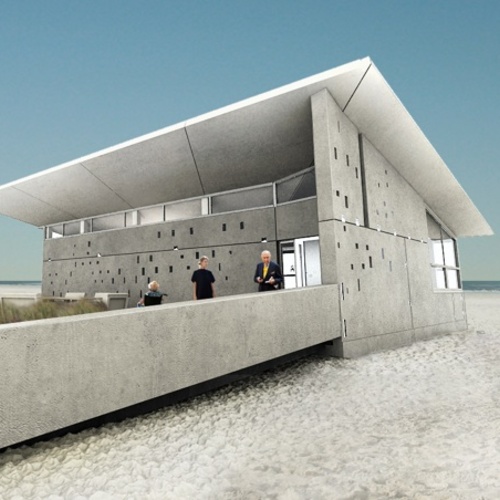
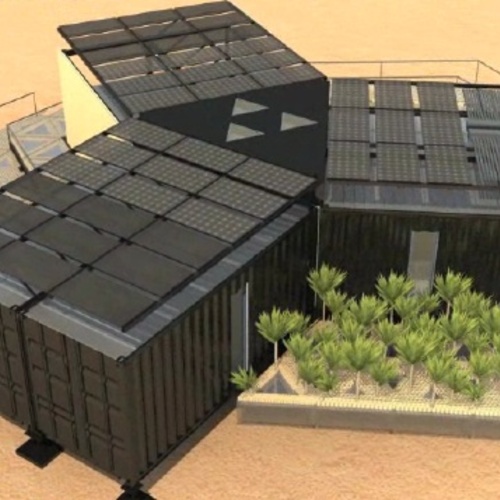
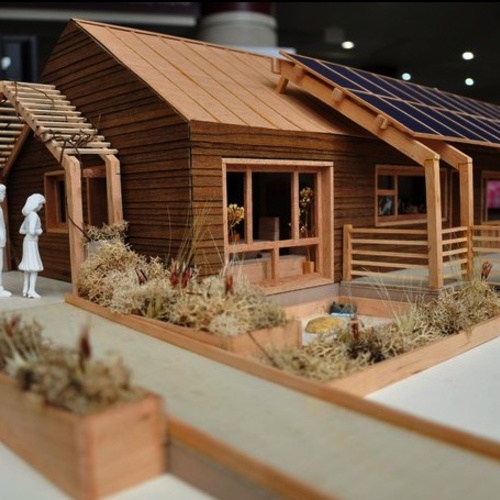
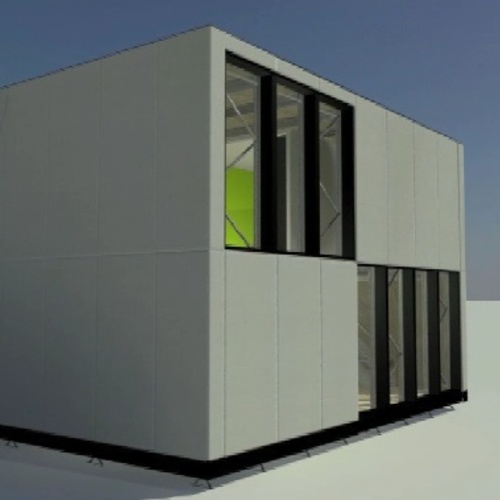






0 Comments
Log in or create an account to post a comment.
Sign up Log in